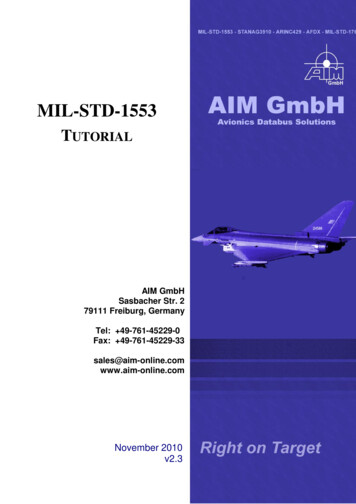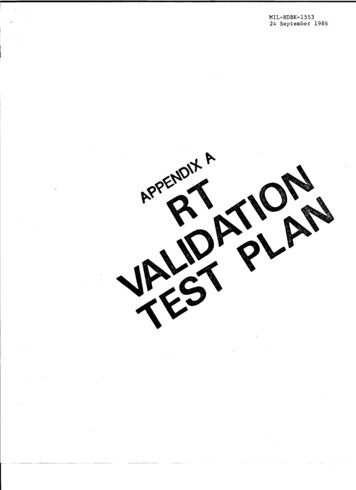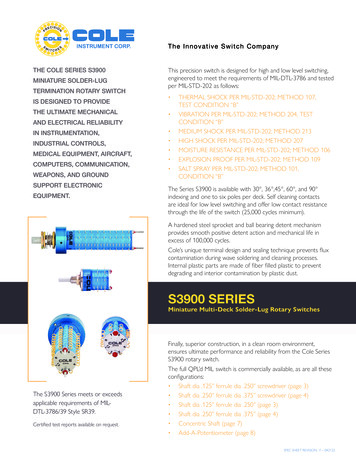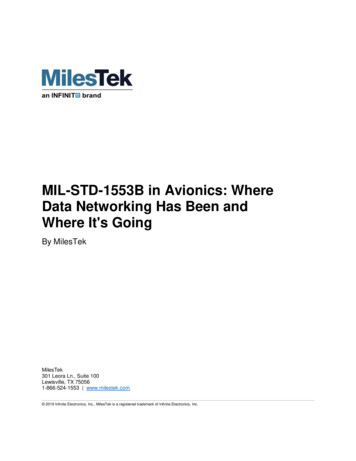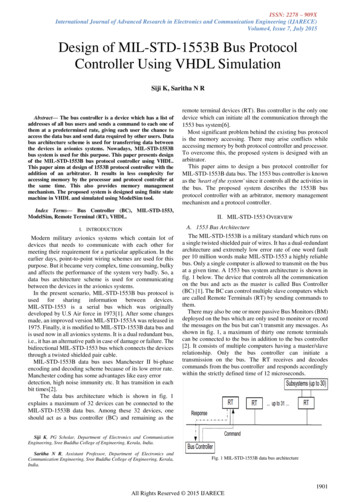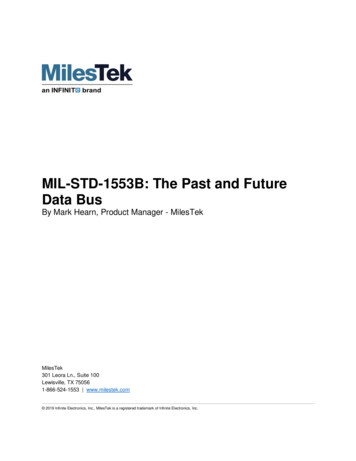
Transcription
MIL-STD-1553B: The Past and FutureData BusBy Mark Hearn, Product Manager - MilesTekMilesTek301 Leora Ln., Suite 100Lewisville, TX 750561-866-524-1553 www.milestek.com 2019 Infinite Electronics, Inc., MilesTek is a registered trademark of Infinite Electronics, Inc.
MIL-STD-1553B: The Past and Future Data BusAs the avionics systems in military aircraft and other platforms increase in performance, the need for MILSTD-1553B may decrease, and some industry pundits project it may soon be relegated to the annals ofhistory. However, such projections have been made for years, and MIL-STD-1553B hasn’t just survivedfor more than four decades--it’s prospered--delivering an unbeatable combination of relative simplicity,modularity, redundancy, and bulletproof reliability. So, there’s ample reason to believe that even withchallenges from Gigabit Ethernet, Fiber Channel, and other higher-performance networks, it will continueto be the “go-to” choice for some defense and aerospace platforms for many years.First, although exact numbers are scarce, MIL-STD-1553B has at least 100 million hours in service onground, sea, air, and space platforms, in countries throughout the world. It also boasts a robust vendorbase, universal recognition in the defense and aerospace community, and is well understood by hugenumbers of technicians and engineers.Second, once placed in service most defense platforms remain there for decades, so current systemsusing MIL-STD-1553 (Figure 1) are likely to be around many years and spares will be always be needed.Wholesale replacement of MIL-STD-1553 with an alternative in these platforms would require newelectronics connected to the bus, an expensive proposition. Third, even though its 1-Mb/s data rate isorders of magnitude slower than more “modern” contemporaries, some platforms simply do not requirehigher speeds (although admittedly, their numbers are declining).Figure 1 A typical MIL-STD-1553B system including remote terminals and bus controllers serving various portions of anaircraft.That said, to retain its relevance in the future MIL-STD-1553B will need to adapt to the modern world.Specifically, this means it’s potential must be more fully exploited to deliver data rates in the hundreds ofmegabits per second. There have been significant efforts to achieve this over the years, principally byData Device Corp. (DDC) and Edgewater Computer Systems beginning in the early 2000s. Unfortunately,this story doesn’t have a very happy ending, even though both companies developed and demonstratednot only that MIL-STD-1553B could be enhanced but was achievable without significantly modifying thestandards underpinnings.www.milestek.com 1-866-524-1553 2019 Infinite Electronics, Inc., MilesTek is a registered trademark of Infinite Electronics, Inc.2
DDC began its efforts with an approach it called Turbo 1553 that increased MIL-STD-1553’s data ratewithout modifying its fundamental features such as its modulation technique, line code, or couplingmethods. Turbo 1553 was shown capable of reliably delivering 5 Mb/s on standard MIL-STD-1553terminals over 430 ft. with 10 stub connections to three remote terminals. The second, called “HighPerformance 1553” or “Hyper 1553” uses frequency-division multiplexing and other techniques to allowhigher speed data to be simultaneously carried along with standard 1-Mb/s MIL-STD-1553 data on thesame bus cable. It was also envisioned to implement a multi-drop bus, which eliminates the need foractive hubs or switches.In Hyper 1553, the 1-Mb/s signals are limited to lower frequencies while the higher speed signals occupyhigher ones. DDC’s experiments using this approach demonstrated that MIL-STD-1553 has enoughbandwidth to allow the concurrent signals to be reliably transferred at higher speeds, depending on thelength of the bus and number of stubs.DDC demonstrated HyPer 1553 in a 2-hr. flight on an Air Force F15-E1 Strike Eagle fighter in 2005,where was used to transfer imagery between a computer in the forward avionics bay and a smart bombmounted on wing pylon. The imagery data was transferred without errors at 40 Mb/s over existing cablingalong with 1-Mb/s traffic. DDC still includes Hyper-1553 capability in its catalog, presumably as customboards.Edgewater was also instrumental in delivering essentially the same result, but it had the benefit of beingunder contract to the DoD to develop its technology, called Extended 1553 (E1553). Edgewater alongwith researchers from the Air Force and Navy worked on the project for several years, and the technologywas flight tested in an Air Force F-16 and Navy F/A-18.The results were very promising but as the program didn’t have the visibility and priority of others, the AirForce cancelled it after spending tens of millions of dollars. It had delivered the desired 200 Mb/s datarate, without the need for huge changes, and allowed legacy MIL-STD-1553 data at 1 Mb/s to be carriedsimultaneously. The company believed it had the potential to reach 500 Mb/s. As Military & AerospaceTechnology Editor John Keller pointed out in 2012, not only had government wasted considerable timeand money, it also lost the opportunity to make MIL-STD-1553B a more viable data bus technology foryears to come.Fortunately, all was not lost as after the Air Force turned off its funding for E1553, the Assistant Secretaryof Defense for Research and Engineering and a consortium from Canada, the U.K., Germany, and othersindicated they wanted to complete the development of E1553. It was tested on several fixed-and rotarywing aircraft, and the NATO Avionics System Panel (AVSP), chaired by the U.S. Navy, sponsoredstandardization efforts within NATO began the ratification process in 2010.The result was a NATO Standardization Agreement (STANAG 7221) and in 2015 the “Broadband RealTime Data Bus Standard” was unanimously ratified by NATO. Unfortunately, 7221 is restricted to a NATOserver so government sponsorship is required to use it, but even with this limitation it is being mandatedon various programs, including fifth-generation aircraft like the F-35 Joint Strike Fighter. Edgewater hassubsequently begun offering PCI and PCIe mezzanine network interface cards that comply with both MILSTD-1553B and STANAG 7221. Considering its restrictions, there is little chance this enhanced MILSTD-1553B technology will make its way into the broad market.While 200 Mb/s and even 500 Mb/s isn’t terribly impressive today, it’s important to remember that it wasachieved on a bus that already serves dozens of different platforms and thousands of individual vehicles,so making the upgrade “should” have been an obvious solution. At 200 Mb/s (two hundred times fasterthan standard MIL-STD-1553B), it could serve not just its traditional command and control functions butalso perform as a “mid-level” solution for transferring the large amounts of data produced by sensors.www.milestek.com 1-866-524-1553 2019 Infinite Electronics, Inc., MilesTek is a registered trademark of Infinite Electronics, Inc.3
The upper-layer protocol of MIL-STD-1553B are also used in other standard, such as FC-AE-1553 andHigh-Speed 1760. FC-AE-1553 uses the MIL-STD-1553B command/response protocol and supports allits core elements including command and status, sub addresses, mode codes, transfers between remoteterminal, error checking, and broadcast. As a result, it allows the reuse of MIL-STD-1553 and MIL-STD1760 commands and legacy software. In addition, FC-AE-1553 includes extensions and optimizationssupporting RDMA to provide direct memory access of remote systems over Fibre Channel.MIL-STD-1760 is typically used for interfacing weapon stores to an aircraft’s control systems but anenhanced version called High-Speed 1760 (SAE standard AS6653) has a high-speed interface based onFibre Channel that can deliver data rates up to 1 Gb/s over two 75-ohm coaxial cables. The FibreChannel upper layer protocols are based on FC-AE-1553, MIL-STD-1553B for command and controlmessaging and FC-AV for transferring images, video, and audio files.The Path from HereFew data buses have withstood the test of time better than MIL-STD-1553 (Figure 2). One obviousreason for this is that the Department of Defense is its primary beneficiary, in which change takes placeover decades rather than months or years. However, it would never have remained relevant for this long ifit weren’t for its inherent, time-tested capabilities. Nevertheless, emerging avionics, weapon systems, andother subsystems bear little resemblance to their predecessors, as they are required to transfer gigabytesor even terabytes of data over relatively short periods of time. This data will come from moresophisticated and higher resolution sensors that are becoming more formidable every year.Figure 2 MilesTek’s TK-1038 is a four-terminal bus kit that includes couplers, terminators, and cable assemblies, and hasbeen a staple for users of MIL-STD-1553B for many years.www.milestek.com 1-866-524-1553 2019 Infinite Electronics, Inc., MilesTek is a registered trademark of Infinite Electronics, Inc.4
With this as a backdrop, it seems obvious that the heyday of MIL-STD-1553B is over and perhaps it is.However, this does not mean a data bus like MIL-STD-1553 will not be needed throughout the nextdecade and perhaps longer, especially as the enhancements within STANAG 7221 have only beenavailable for about two years. In addition, even if MIL-STD-1553B itself declines in significance, its basicstructure is included in other standards such as MIL-STD-1760 and FC-AE-1553, so it will live on invisiblywithin them for decades or more.This article was originally published in High Frequency Electronics Magazinewww.milestek.com 1-866-524-1553 2019 Infinite Electronics, Inc., MilesTek is a registered trademark of Infinite Electronics, Inc.5
As a result, it allows the reuse of MIL-STD-1553 and MIL-STD-1760 commands and legacy software. In addition, FC-AE-1553 includes extensions and optimizations supporting RDMA to provide direct memory access of remote systems over Fibre Channel. MIL-STD-1760 is typically used for interfacing weapon stores to an aircraft's control systems but an
